Preparing for Travel with Dogs: Essential Tips for a Smooth Journey
Traveling can be a fantastic experience, and bringing your dog along for the adventure can enhance the joy of your journey. However, there are critical preparations required to ensure that your pet is safe, comfortable, and welcome wherever you go. You need to consider the mode of transportation, pet-friendly accommodations, and a plethora of regulations that can affect your canine companion.
Understanding your dog’s needs and temperament is essential when planning a trip. Long car rides and air travel can be particularly stressful for pets if not properly managed. It’s necessary to familiarize yourself with pet policies of airlines, hotels, and destination-specific regulations ahead of time. By preparing correctly, you can avoid last-minute hassles and ensure both you and your dog have a pleasant experience.
Packing for your dog is just as important as packing for yourself. This includes not only food, water, and toys but also any medication, vaccination records, and identification tags. Establishing a checklist and gathering travel essentials well before your departure can eliminate the stress of forgetting vital items and help maintain your dog’s routine in a new environment. With thorough preparation, travel with your dog can be an enriching and hassle-free experience.
Understanding Pet Travel Requirements
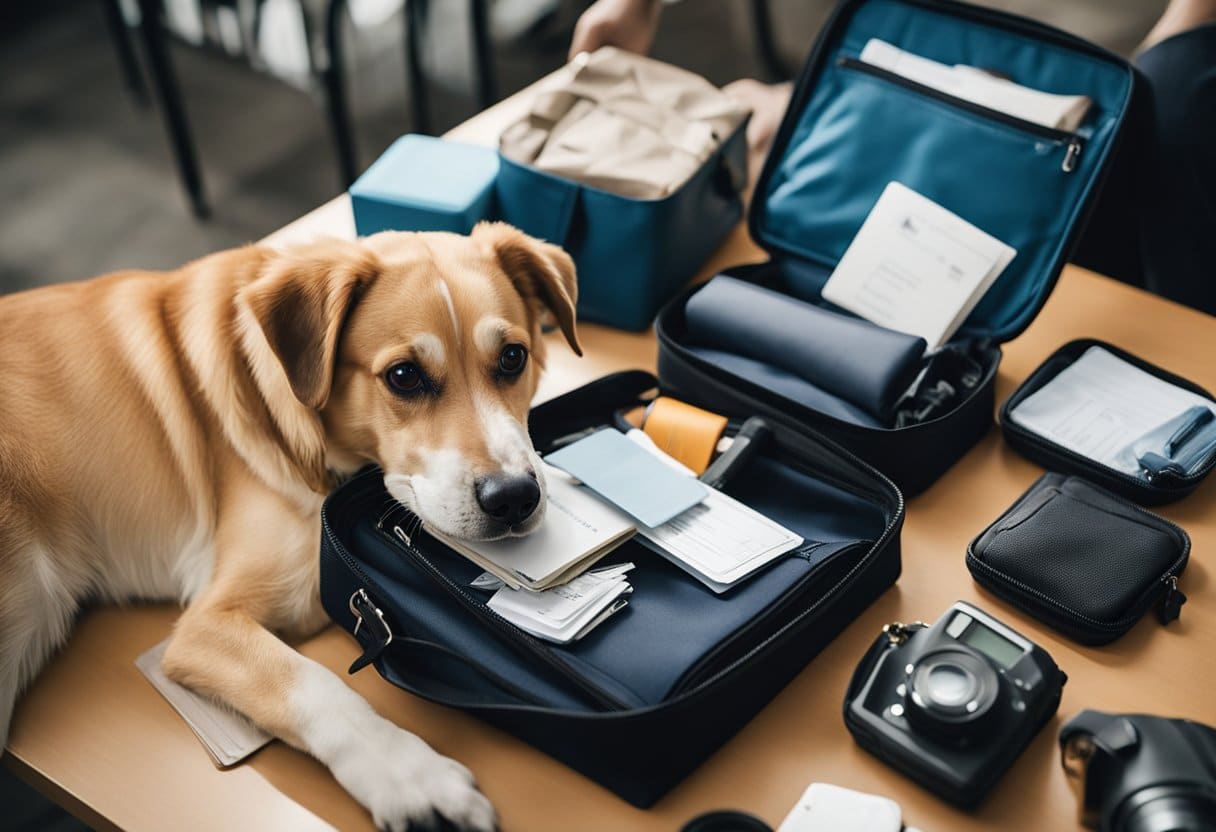
When planning to fly with your dog, thorough preparation and an understanding of the varying requirements from different airlines are essential for a smooth experience.
Researching Airline Pet Policies
Every airline has its specific set of pet travel policies that you need to adhere to. It’s important to research:
- Size and weight restrictions: Airlines have particular size and weight limits for pets, both for cabin and cargo travel.
- Breed restrictions: Certain breeds, especially snub-nosed dogs, may have travel restrictions due to health risks.
- Carrier requirements: Airlines stipulate specific dimensions and types of carriers. For in-cabin travel, carriers must typically fit under the seat in front of you.
- Fees: Understand the fees associated with pet travel, which may vary by airline and destination.
To research, visit each airline’s official website or contact their customer service directly for the most accurate and up-to-date information.
Preparing Necessary Travel Documents
A crucial aspect of traveling with your dog is ensuring that all necessary travel documents are ready:
- Pet Passport or Vet Health Certificate: Depending on your destination, you may need an EU Pet Passport or a health certificate signed by a licensed veterinarian.
- Proof of Vaccinations: Most airlines and destinations will require proof of up-to-date vaccinations, with the rabies vaccination being particularly important.
- ID Tags: Ensure your pet’s collar has up-to-date ID tags with your contact information. Microchipping is also highly recommended.
Always check with the relevant authorities of your destination country for specific requirements to avoid any last-minute issues. Keep a well-organized folder with all your pet’s travel documents easily accessible throughout your journey.
Health and Safety Considerations
Before embarking on a journey with your dog, addressing health and safety concerns is paramount for a smooth and stress-free trip. Ensuring your pet is fit to travel and has all the necessary documentation makes the journey safer for both your dog and others.
Consulting a Veterinarian
Before traveling, schedule a visit with your veterinarian for a physical exam. Your vet can assess your dog’s health and advise on any necessary medications or precautions. Make sure your dog is up to date with all vaccinations, including rabies, and discuss heartworm prevention, especially if you’re traveling to an area where it’s prevalent.
- Vaccinations: Ensure core vaccines are up-to-date (DHPP, rabies).
- Heartworm Prevention: Vital if traveling to endemic areas.
- General Health: Vet to confirm overall fitness for travel.
Carrying Health Certificates and Vaccination Records
It is crucial to bring along authorized health certificates and vaccination records. Some regions require proof of vaccination, and health certificates often need to be issued within a certain timeframe before travel.
- Health Certificate: Typically signed by a vet, confirming your pet is free of diseases.
- Vaccination Record: Current records proving vaccination against rabies and other diseases.
- Microchip Information: If your dog has a microchip, carry the information with the records.
| Document | Description |
|---|---|
| Health Certificate | Issued by a vet, confirming your dog’s health |
| Vaccination Record | Lists all current vaccinations and dates |
| Microchip Information | Provides the microchip number and registry details |
Preventing Diseases and Parasites
Protection against diseases and parasites is a critical aspect of your dog’s health. Administer appropriate flea, tick, and other parasite preventatives as advised by your vet. Understand the risks in your destination and prepare accordingly.
- Flea and Tick Prevention: Apply or administer preventatives before travel.
- Disease Risk: Know the risks of the area (e.g., Lyme disease).
| Parasite Prevention | Application | Effective For |
|---|---|---|
| Fleas and Ticks | Topical/Oral | Several weeks/months |
| Heartworm | Oral | One month |
Traveling with your dog requires you to be attentive to their health and safety needs. With the proper preparation, you can help guarantee a safer journey for both of you.
Selecting the Right Pet Carrier
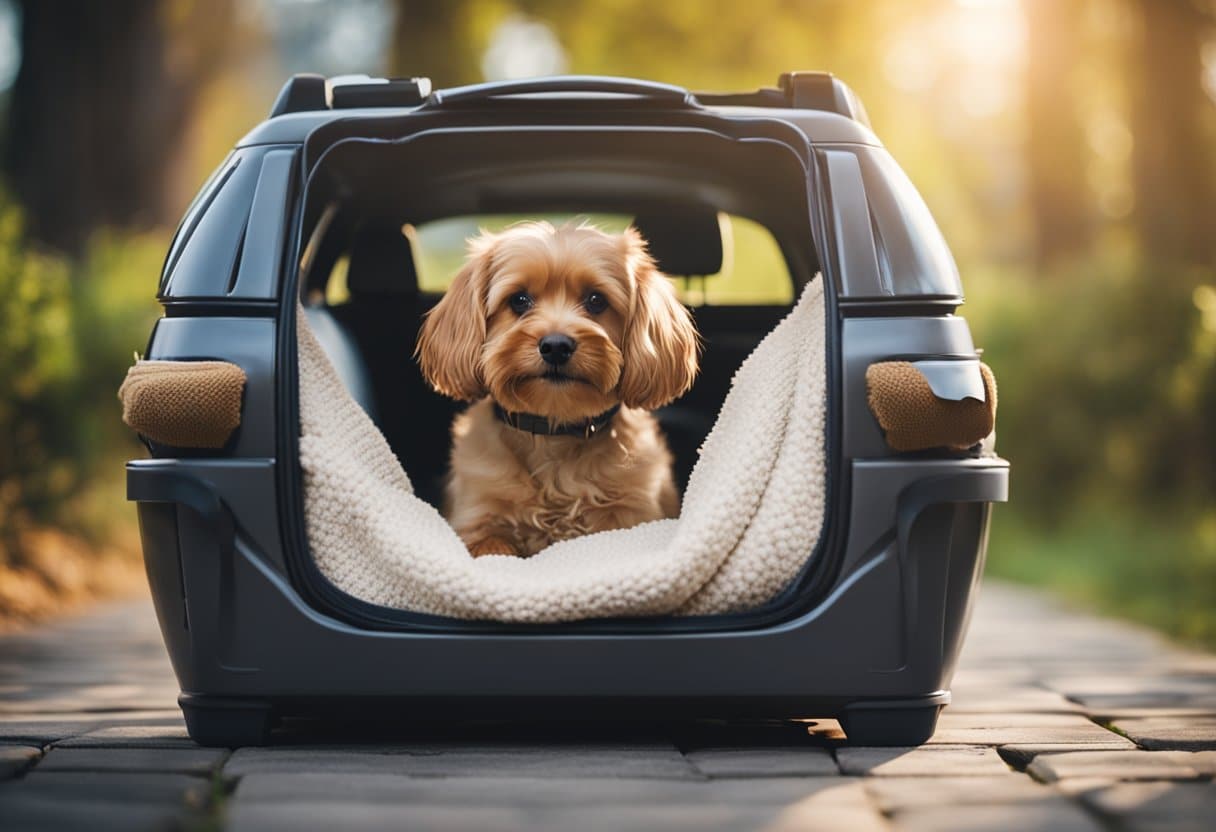
When traveling with your dog, the right pet carrier ensures their safety and comfort, and complies with the transportation regulations.
Air Travel
For flights, your pet carrier must meet specific airline standards. It should be leak-proof and be able to fit comfortably under the seat as a carry-on if you’re bringing your pet in the cabin. Check the airline’s size and weight restrictions—the maximum size commonly allowed is about 17″ long x 11″ wide x 7.5″ high for soft-sided carriers. The carrier must also have adequate ventilation on at least two sides. Hard-sided carriers are a requirement for dogs traveling as cargo. Moreover, many airlines require the carrier to be IATA (International Air Transport Association) compliant.
- Size and Fit: Ensure the carrier is large enough for your dog to stand, turn around, and lie down comfortably.
- Material: Opt for durable materials—hard-sided for cargo, soft-sided for cabin.
- Ventilation: At least two sides should have proper ventilation.
Train and Bus Journeys
When it comes to train or bus travel, rules for pet carriers can vary depending on the company. Generally, the pet carrier is considered a piece of carry-on luggage and must be able to fit in the luggage compartment or under your seat. It often needs to be soft-sided to be easily stowable.
- Leak-Proof Bottom: To prevent any accidents, ensure the carrier has a sturdy, leak-proof bottom.
- Access and Comfort: Select one that has a secure opening and gives your dog a comfortable travel experience.
- Visibility and Air Flow: Ensure there’s good visibility for your dog and proper airflow.
By adhering to these guidelines, you’ll be able to select a pet carrier that will make travel with your dog seamless and stress-free.
Training and Conditioning Your Dog for Travel
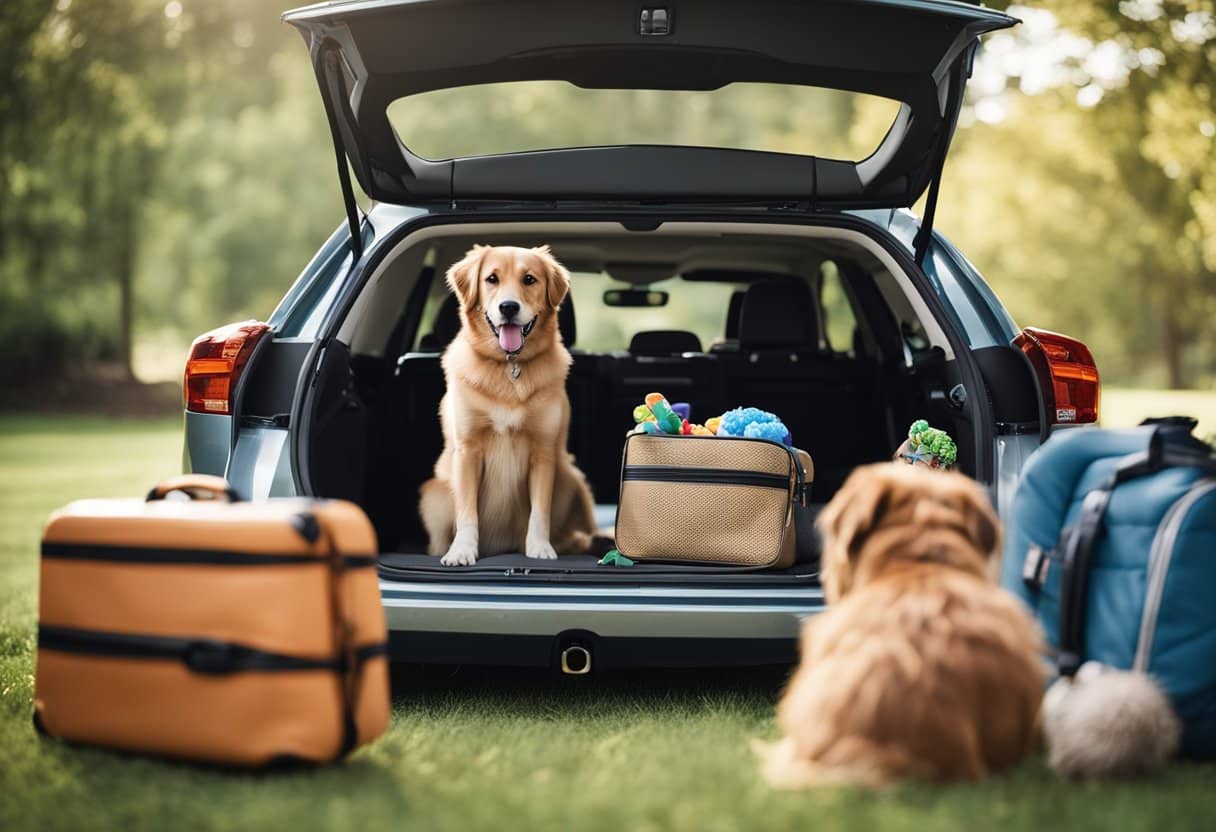
Preparing your dog for travel requires focused training and conditioning to ensure their safety and comfort. By addressing both behavior and adaptability to travel environments, you can minimize stress and anxiety for both you and your pet.
Behavioral Training
Your dog’s behavior is a critical factor when traveling. Training should emphasize obedience and manners in different environments, ensuring your dog is well-behaved regardless of the setting. Begin with basic commands like sit, stay, and come, which can be crucial in maintaining control in unfamiliar places. Regular exercise is essential, not only for physical health but also to reduce excess energy that could exacerbate anxiety during travel.
Consistency is key; rehearse these commands daily to reinforce their importance. To address issues like separation anxiety, gradually accustom your dog to spending time alone, starting with short intervals and slowly increasing the duration. This will be particularly helpful in situations where they can’t be by your side during your travels.
Adapting to Carriers and Vehicles
Familiarizing your dog with their travel carrier and vehicle is important for safety and reducing travel-related stress. Begin by allowing your dog to explore the carrier at their own pace, with the door open, and placing comfortable bedding and favorite toys inside.
| Stage | Activity | Purpose |
|---|---|---|
| Introduction | Place the carrier in a common area with the door open. | Encourages exploration and positive association. |
| Meal Times | Feed meals near, and eventually inside, the carrier. | Builds positive associations with the carrier. |
| Short Sessions | Practice short, closed-door sessions in the carrier. | Prepares for longer containment during travel. |
Transition to short car trips, securing the carrier in the vehicle. Ensure that your dog is leashed and harnessed for additional safety during entry and exit from the car to prevent them from escaping or getting injured. Introduce longer car travel sessions gradually, providing treats and praise to create a positive association. If your dog shows signs of anxiety or discomfort, take a step back in the process, reducing travel time and working up more slowly.
Remember, patience and gradual exposure are foundation stones for a comfortable travel experience for your dog.
Planning the Journey
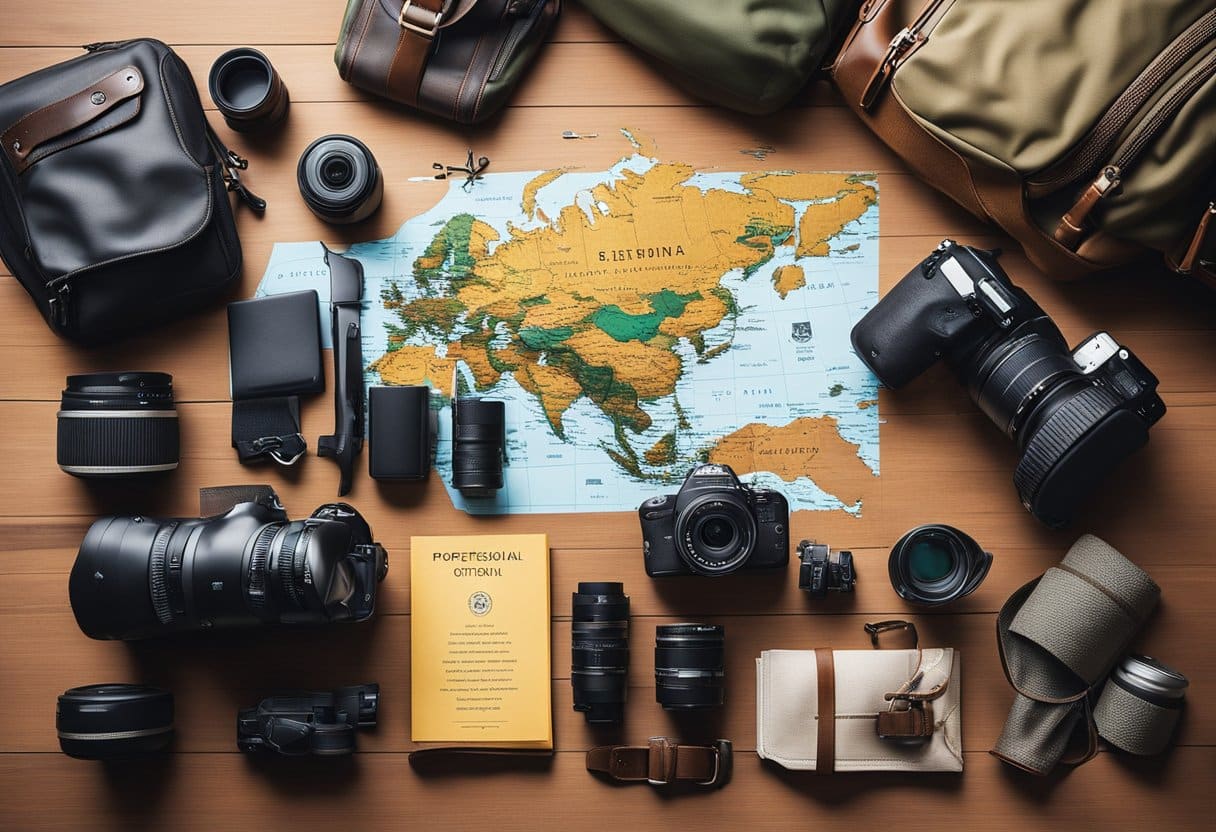
When preparing to travel with your dog, selecting a suitable mode of transport and considering timing for the journey are crucial to ensure your pet’s comfort and safety.
Choosing Suitable Modes of Transport
Flights: Confirm that the airline accommodates dogs and inquire about their pet policies. Opt for non-stop flights when possible to minimize stress on your pet. Airlines often have requirements for pet carriers, so check the size and construction specifications before you book.
- Bus: Not all bus services accept pets, so verify with the company beforehand. Smaller dogs typically need to be in a carrier, while larger dogs may have specific restrictions or guidelines.
- Cruise: Cruises can be more pet-friendly, but it’s important to check the availability of pet amenities onboard, such as kennels or pet play areas.
- Car: If you’re driving, ensure your dog’s travel carrier or harness is secure within your vehicle. Plan for regular breaks to allow your dog to stretch and relieve itself.
Remember to consider your dog’s temperament and any special requirements they might have while traveling.
Timing and Layovers
Schedule your travels to avoid extreme weather conditions that can put your dog at risk, such as high temperatures that can cause heatstroke or very cold climates that can lead to hypothermia.
- Direct Flight vs. Layover: Choose direct flights to minimize travel time. If layovers are unavoidable, select an itinerary that allows sufficient time for your dog to be taken out of its carrier, fed, and given a water break.
- Travel time planning: For bus or car trips, chart out your journey with planned stops every 2-3 hours for your dog’s needs. If the weather is hot, avoid the midday heat when scheduling breaks.
- Feeding schedule: Adjust your dog’s feeding schedule to prevent travel sickness. A light meal a few hours before departure is usually recommended.
By carefully planning the modes of transport and timing, you can create a more comfortable journey for both you and your dog.
Packing Essentials for Your Dog
When preparing for a trip with your dog, it’s crucial to pack all the necessary items they will need for comfort and sustenance. This list ensures you have the essential supplies ready in your luggage or suitcase, helping to make your dog’s travel experience pleasant and stress-free.
Food, Water, and Snacks
- Food: Pack enough of your dog’s regular food for the entire trip. Measure out each meal and store it in zip-lock bags or an airtight container. This avoids any digestive issues that can arise from switching foods.
Meal Time Amount of Food Breakfast 1 cup Dinner 1 cup - Water: Always have a portable water bottle or collapsible bowl, so your dog stays hydrated. Carry a jug of water if you’ll have limited access to clean water sources.
- Snacks: Bring your dog’s favorite treats to reward them and keep them content during the journey. This is especially useful for long distances or if you encounter any delays.
Toys and Comfort Items
- Dog Toy: Choose a favorite toy or two to help your dog feel secure and entertained during the trip. Durable chew toys or a beloved stuffed animal can provide comfort and a sense of normalcy.
- Comfort Items: Include items with familiar scents, like a blanket or bed, especially for dogs with snubbed noses who may experience more travel anxiety. These items are important for your pet’s sense of property and well-being.
Managing On-the-Go Needs
When traveling with your dog, it’s important to consider their on-the-go needs, which include regular potty breaks and managing motion sickness.
Regular Potty Breaks and Exercise
Potty Breaks: Plan for potty breaks every 2-4 hours to allow your dog to relieve itself. Bring poop bags to clean up after your pet and dispose of waste properly. Identify dog-friendly areas along your route to ensure that there are safe places for these stops.
Exercise: Dogs need to stretch their legs and expend energy. Incorporate short walks or playtime during potty breaks. Not only does this keep them healthy, but it can also help prevent restlessness during the journey.
Handling Motion Sickness
Preparation:
- If your dog is prone to motion sickness, consult with your vet to discuss medications or natural remedies.
- Avoid feeding your dog a large meal before traveling; a light meal 3-4 hours prior can help.
Comfort: Ensure your dog’s travel area is well-ventilated and comfortable. A familiar blanket or toy can help them feel more relaxed. Drive smoothly to minimize the chances of car sickness.
Remember to keep your dog’s microchipping details up-to-date in case of an emergency, and familiarize yourself with pet travel guidelines for a safe and pleasant trip.
Accommodation and Destination Tips
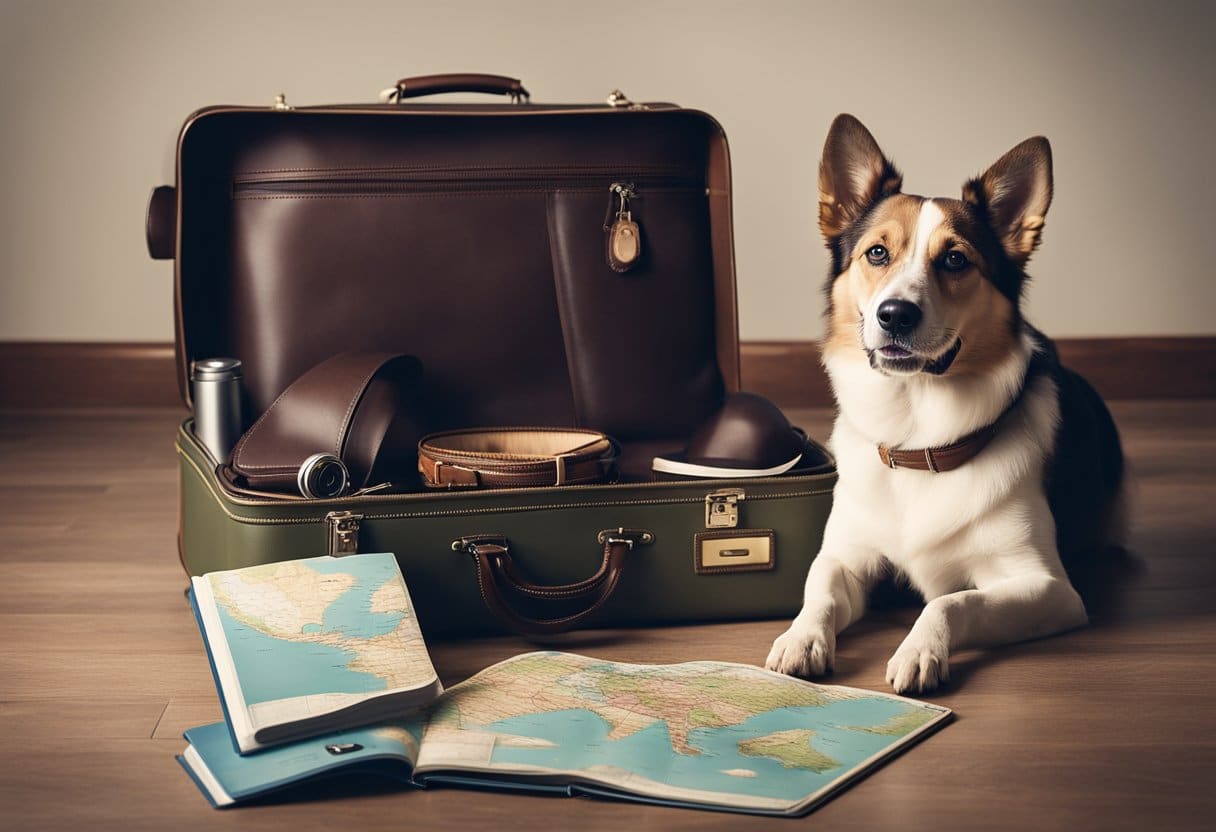
When traveling with your dog, the right accommodation and destination choice can significantly enhance your experience. Proper planning ensures that both you and your pet have a comfortable and enjoyable trip.
Booking Dog-Friendly Lodging
Research: Prior to booking, verify each property’s pet policy to ensure it accommodates dogs and understand any fees or restrictions. Websites specializing in dog travel may list dog-friendly hotels, making it easier to find suitable options.
- Confirm Details: Reach out to the hotel or rental property to inquire about specific pet accommodations such as designated dog areas or special amenities for dogs. Remember, some accommodations may offer special services for service dogs without extra charges.
- Consider Size: If traveling with a larger breed, check for size limitations; some properties only welcome small to medium-sized dogs.
- Ask About Perks: Some dog-friendly properties may offer complimentary dog beds, bowls, or treats.
Exploring Dog-Friendly Destinations
Local Activities: Look for destinations with dog-friendly activities. Outdoor spaces, like beaches and parks, often welcome dogs, but always check for leash laws and area-specific rules.
- Understand Access: Make sure to check whether family-friendly attractions permit dogs and whether any local transportation systems allow your four-legged family members to join you.
- Boarding Options: For days when dogs might not be able to accompany you, research local boarding services or doggy daycare options in advance.
- Safety First: Always prioritize your dog’s safety and comfort when exploring. Carry a travel guide for dogs to reference local vet services and regulations.
Frequently Asked Questions
When preparing to travel with your dog, it’s important to consider their safety, comfort, and the regulations of your destination. Here are some common questions and clear, accurate answers to help guide you.
What are the necessary steps to prepare my dog for air travel, particularly for in-cabin flights?
To prepare your dog for in-cabin air travel, contact the airline for their pet policies, as requirements vary. Typically, you’ll need an airline-approved carrier, health certifications, and proof of vaccinations. Book early to secure a spot since airlines limit the number of in-cabin pets.
How long can a dog comfortably travel in a car, and what preparations should I consider for long-distance journeys?
Dogs can typically travel in a car for 2-3 hours before needing a break. For longer distances, plan for regular stops for exercise and bathroom breaks, and ensure your dog has access to water and is secured with a harness or travel crate.
When planning to travel internationally with my dog, what health and safety considerations should I keep in mind?
Check the destination country’s pet import requirements well in advance. These may include microchipping, vaccinations, parasite treatments, health certificates, and quarantine periods. Consult with a veterinarian to ensure your dog’s health and compliance with international standards.
What are the most effective strategies for keeping a dog calm and safe while traveling by car?
To keep your dog calm and safe in a car, use a well-ventilated crate or harness attached to a seatbelt. Familiar items like toys or blankets can help soothe them. Condition your dog to car travel by taking short trips and gradually increasing the duration.
Are there any budget-friendly tips for transporting a dog without compromising on their comfort and well-being?
For budget-friendly dog transport, invest in a durable travel carrier that can be reused. Consider traveling during off-peak seasons for lower fees, and bring your own dog food and water to avoid purchasing expensive items on the go.
Before embarking on a flight with my dog, should I restrict their water intake, and how can I ensure they stay hydrated?
Do not significantly restrict your dog’s water before flying, as hydration is important. Offer water right up until departure and upon arrival. During the flight, absorbent bedding in the carrier can help manage accidents without dehydration.

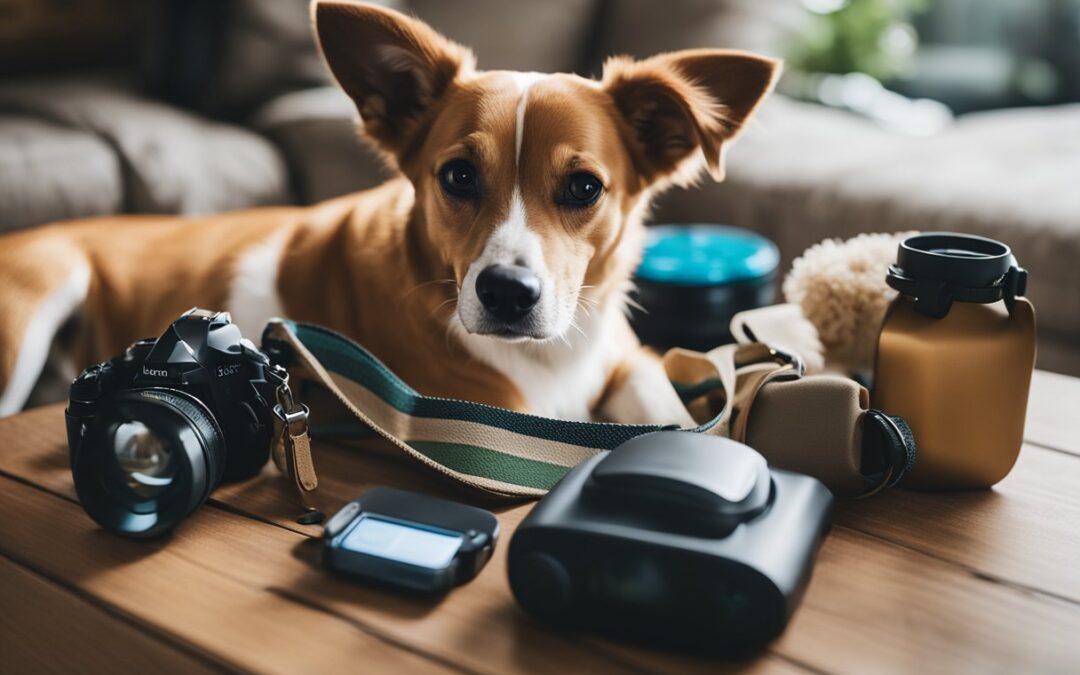
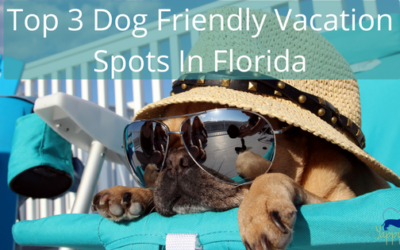
Recent Comments